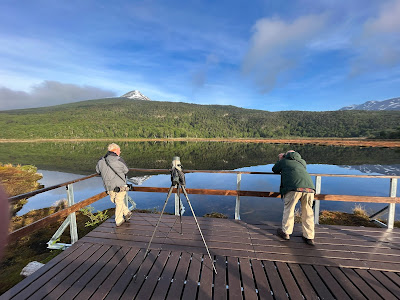Argentina: Pampas to Patagonia (Part 7: Ushuaia cleanup, Ceibas)
Nov 6
Our final day in Ushuaia left us with only longshot species in play. Aerolineas Argentinas had moved our departing flight up a couple hours, so we had only a half-day to work with. We knew that we wanted to owl in the park predawn, but had to choose between Garibaldi Pass for seedsnipe or the park for Spectacled Duck, Magellanic Tapaculo, and Patagonian Tyrant (all three of which are super tough here). Though we realized that the seedsnipe was the real prize, our lack of familiarity with Garibaldi plus the earlier flight made the decision for us. We will just have to return for an Antarctic cruise and prioritize the seedsnipe then!
We began owling in the valley just outside the park entrance at 3:45am, and to our disappointment, the eastern sky was already beginning to glow! The spring days are really long here, which is wonderful except when you're searching for nocturnal creatures. Time was short and we had two targets: Rufous-legged Owl and Lesser Horned Owl (AKA Magellanic Horned Owl, recently split from GHOW). Nothing was calling outside the park, so we drove in. Just as the dawn chorus was beginning and we were starting to lose hope, a RUFOUS-LEGGED OWL called from across a bog. A visual encounter would have been preferred, but hearing the bird's classic hoot was pretty neat.
We were already in prime position to hit the Spectacled Duck spots for the fourth time this week, hoping that an early morning visit would do the trick. Unfortunately we never did connect with that bird. With no recent Tapaculo reports, we knew we'd have to get very lucky, so we were not surprised to dip on that species too. The closest we got to a new bird this morning was the probable calls of a Patagonian Tyrant. However we were never able to view the bird and wondered if one of the Austral Thrush's high-pitched calls could have fooled us.
We really enjoyed our final encounters with many of the park's signature species, including multiple male MAGELLANIC WOODPECKERS, one of which put on a show below eye level.
 |
| male Magellanic Woodpecker |
We departed that afternoon for Buenos Aires, where we would have a 24-hour layover. The flight went off without a hitch, we collected our rental car and drove to our nearby Airbnb.
Nov 7
For our final day in Argentina we had options. The famous Costanera Sur, an urban coastal reserve/park, is actually closed on Mondays, so that was out of the question. Not far northwest of the city is Otamendi Reserve, a reliable place to see the furtive Straight-billed and Curve-billed Reedhaunters. But at this point in the trip we were not really moved by the thought of more brown-and-white marsh birds, so we aimed higher and drove two hours north to the town of Ceibas in southern Entre Rios province. Why not go out with a bang, right? Just driving that extra bit towards the northern edge of the Pampas would put into play many more species.
We began by taking the road heading east from town, which started through a dry, scrubby woodland. Birds seemed to be everywhere, and immediately we were ticking new species left and right. WHITE-FRONTED and CHECKERED WOODPECKERS were particularly active. We saw several NARROW-BILLED WOODCREEPERS before finally laying eyes on a pair of impressive SCIMITAR-BILLED WOODCREEPERS.
LITTLE THORNBIRD was a target here, and we managed to find a couple. BROWN CACHALOTE was a species we missed further south, so finding a noisy party of those was a highlight of the morning. Though an ovenbird, these cachalotes were very reminiscent of jays in structure, behavior, and voice.
Other satisfying finds along this particular stretch of road included BLACK-CAPPED WARBLING FINCH and the very cool LARK-LIKE BRUSHRUNNER. And after a bit of trolling with recordings, we finally had a pair of GIANT WOOD-RAILS respond and make a brief appearance.
Eventually the dry woodland gave way to wetter habitat that included roadside pools, the first of which held several PANTANAL SNIPE and RINGED and BRAZILIAN TEAL, plus loads of other good stuff.
We soon took a right-hand turn over a wet culvert that harbored SOLITARY BLACK CACIQUE and RUFOUS-CAPPED ANTSHRIKE. In the adjacent marsh grass were YELLOW-CHINNED SPINETAIL and SOUTHERN YELLOWTHROAT.
Water levels were rather low, which meant plenty of exposed mud. Migrant shorebirds were scattered throughout. One of my most-wanted birds here was SPOT-FLANKED GALLINULE, and we found several in this particular area.
The birding in Ceibas was truly fantastic. It was nonstop for six hours just along these two roads. We ended up with a whopping 112 species for the morning, 39 of which were new for the trip! It would have been difficult to imagine ending our journey in better fashion. Lunch this afternoon was particularly satisfying. We returned to our Airbnb, cleaned up, repacked, and headed to the airport for our redeye flight home!
- Nick







Comments
Post a Comment